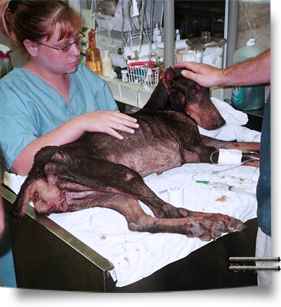Tiny Heartbeats Amid The Wreckage


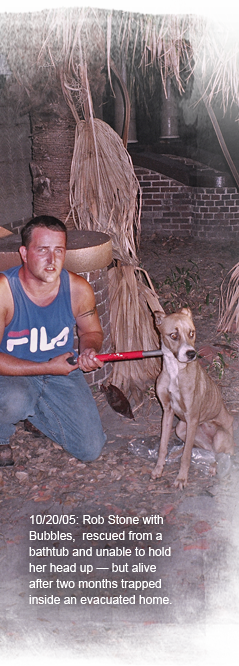


by Brenda Shoss, 11/15/05
"We have her," rescuer Jane Garrison says.
Three simple words. But for an 84-year-old woman in a Baton Rouge intensive care unit, they are reason to live. This Katrina victim's cat is alive, seven weeks after the storm.
As hurricane headlines vanish from daily news, a little dog dubbed Bubbles is found in a bathtub too weak to lift her head. A skin-and-bones Doberman mix is plucked from the trash. Some burrow under homes or linger in familiar yards. They are stealth shadows, glimpsed after dark. Many companion animals still fend for themselves in the aftermath of Katrina and Rita.
Dear Leibchen,
We all knew you, left behind and tossed in the trash to die. When you were found, we prayed for you. When you walked out of the hospital with your Foster Mom, we rejoiced. And when you died, we wept for a world without you in it. In the end, you were loved for one perfect moment.
Brenda Shoss, Kinship Circle
On 10/1/05 Lamar Dixon, the state designated shelter in Gonzales, LA, phased out operations under Humane Society of the United States. Jane Garrison, a volunteer with HSUS rescue, now directs Animal Rescue New Orleans (ARNO), one of few recovery missions left in New Orleans.
"Many of these animals are people's companions who escaped their homes when doors and windows blew open. It would be completely unethical to allow them to die on the streets," says Garrison, who struggles to recruit enough volunteers to dispense food/water at over 2,000 locations in and around New Orleans.
My own commitment to these animals began shortly after Katrina hit. That's when I found my four-year-old son, a Cartoon Network junkie, glued to CNN Headline News.
"Mommy," he explained, "I want to see if the people get out of their broken houses."
I wept for the people adrift on tree branches and floating down streets. But in the same instant, I knew who would be overlooked: Outgoing boys with floppy paws. A spoiled princess who slept on their beds. A soft tabby who nestled in their laps.
In early September Kinship Circle, a nonprofit animal advocacy organization, formed an alliance with Animal Rescue Foundation (ARF), a no-kill shelter in Mobile, Alabama.
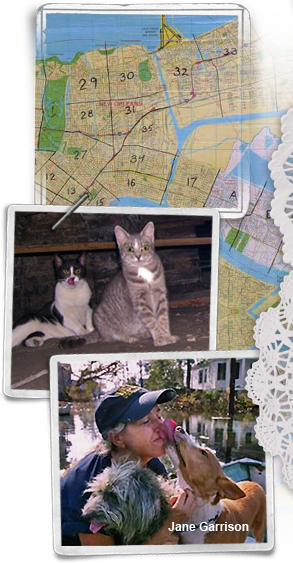
ARF's Julia Fischer and I mobilized volunteers and supplies to over 80 shelters and triage sites across Louisiana, Mississippi, Alabama and Texas. Under the banner Grassroots Effort for Animals of the Storm, truckloads of cages, live traps, hay and horse feed left our storehouse in Mobile. By mid-October, we'd distributed over 20,000 pounds of animal food, 1,000 pounds of kitty litter, 500 crates, $5,000 worth of vaccines, $10,000 in veterinary supplies, 10 pallets of water, and more than 5,000 bowls, leashes, collars, and toys.
About the time my son thought Mommy had mutated with her computer and phone, evacuee Brenda Johnson called. She begged me to find her dog, an 11-year-old Yorkshire terrier trapped in an apartment on Roger Drive in New Orleans East. "Can you save our Spike? He's big, probably 15 pounds. We thought we'd be back in a couple of days…"
As Brenda spoke I overhead children, an aunt, a niece and a brother from her crowded hotel room. I also heard the despair in her voice. I filed reports and perused lost pet photos. I granted rescuers permission to break into Brenda's apartment. But with each passing day I wondered, "Will the heat, starvation, or water finally take him?"
Spike's uncertain fate haunted me. His salvation, along with tens of thousands of stranded companion animals, seemed contingent on little more than chance. Eleven days post-Katrina, rescuer Paul Berry of Best Friends in Kanab, Utah, wrote: "You hear fluff pieces on TV about people reunited with their pets. But [from the boats] you see this vast, endless wasteland of toxic water… and animals clinging to life."
About the time my son thought Mommy had mutated with her computer and phone, evacuee Brenda Johnson called. She begged me to find her dog, an 11-year-old Yorkshire terrier trapped in an apartment on Roger Drive in New Orleans East. "Can you save our Spike? He's big, probably 15 pounds. We thought we'd be back in a couple of days…"
As Brenda spoke I overhead children, an aunt, a niece and a brother from her crowded hotel room. I also heard the despair in her voice. I filed reports and perused lost pet photos. I granted rescuers permission to break into Brenda's apartment. But with each passing day I wondered, "Will the heat, starvation, or water finally take him?"
Spike's uncertain fate haunted me. His salvation, along with tens of thousands of stranded companion animals, seemed contingent on little more than chance. Eleven days post-Katrina, rescuer Paul Berry of Best Friends in Kanab, Utah, wrote: "You hear fluff pieces on TV about people reunited with their pets. But [from the boats] you see this vast, endless wasteland of toxic water… and animals clinging to life."
Some nights, my friend Tim Gorski phoned from the Winn Dixie parking lot while volunteering with Grass Roots Animal Rescue. Behind his voice, I heard faraway barks and howls cast into the darkness.
A strategy to accommodate animals might have lowered the human death toll. On September 8, CNN listed "People won't leave their pets" as a chief reason some 10,000 stragglers would not vacate their homes under Mayor Ray Nagin's mandatory evacuations.
Any disaster plan that forces victims to choose between survival and their animals is a bad plan. Post-Katrina images are unforgivable: A white dog is ripped from a boy's arms as he boards a bus. A yellow Lab, marooned on a rooftop, watches his family disappear in a helicopter. An elderly woman cannot receive medical care unless she deserts her cats.
When Katrina hit Plaquemine Parish, south of New Orleans, uprooted homes, farms, and trees blew over highways and beaches. Two protective levees crumbled. Oil tanks exploded, coating the area (and animals) in millions of gallons of black crude.
A strategy to accommodate animals might have lowered the human death toll. On September 8, CNN listed "People won't leave their pets" as a chief reason some 10,000 stragglers would not vacate their homes under Mayor Ray Nagin's mandatory evacuations.
Any disaster plan that forces victims to choose between survival and their animals is a bad plan. Post-Katrina images are unforgivable: A white dog is ripped from a boy's arms as he boards a bus. A yellow Lab, marooned on a rooftop, watches his family disappear in a helicopter. An elderly woman cannot receive medical care unless she deserts her cats.
When Katrina hit Plaquemine Parish, south of New Orleans, uprooted homes, farms, and trees blew over highways and beaches. Two protective levees crumbled. Oil tanks exploded, coating the area (and animals) in millions of gallons of black crude.
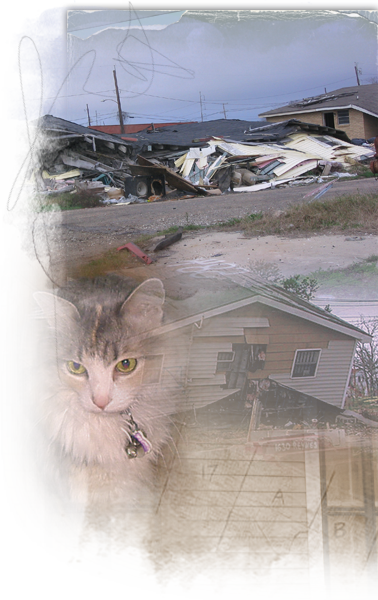

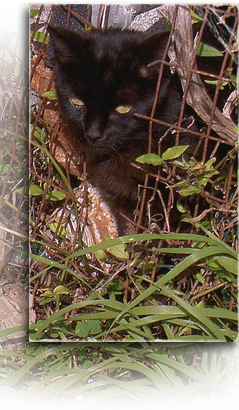
Still, life persevered. Dogs swarmed Guardsmen for food and water. Cats devoured MREs from these kindhearted troops. Bewildered horses were submerged in water and cows floated in watery fields.
I contacted the New Mexico National Guard to gain entry into "no-go" Plaquemines. I found a kindred spirit in Major Kimberly Lalley. Soon rescue teams led by Chris and Sarah Stevens and Terri Kelley of Indiana cleared security checkpoints with permission from Colonel Dick Almeter.
The problem with the animal disaster plan? There was no comprehensive plan – other than the mercy of volunteers, soldiers or law enforcers.
Once the people search diminished to body retrieval, why didn't the White House, the Defense Department, the Department of Homeland Security, and the states of Louisiana and Mississippi authorize active and reserve component troops to conduct animal rescue and relief missions?
With human aid well underway, why didn't Governors Blanco and Barbour direct rescue boats, air-conditioned trucks, medical personnel and other responders to recover animals?
Instead, the world witnessed an unprecedented phenomenon: Entire ghost towns filled with dogs, cats, birds and horses. Among them, a beloved Yorkie named Spike waited beneath a child's bed.
On 9/16/05 Brenda Johnson called me. "They found Spike. He is alive." This elderly dog, prone to seizures, survived without food or water for over two weeks.
My plea for Spike had reached the Jefferson Feed store, a makeshift triage site in New Orleans. From there, someone named Jennifer contacted Nathalie, who communicated with ground crews from her home in New Jersey. Finally, two vet techs with Florida's Collier County Animal League happened to be with police and firemen when they got Spike's report. Under official escort, they broke into Brenda's flooded home with a huge "Hello!" for the little Yorkie.
An animal's life often depended upon an out-of-state network in the right place at the right time.
By October's end, guardian requests to find lost animals still poured in. Yet the state declared local animal control in charge, essentially ordering non-Louisiana volunteers to go home.
Governor Kathleen Blanco, under advisement from Assistant State Veterinarian Martha Littlefield, refused to extend Executive Order KBB 2005-35 for licensed out-state veterinarians to temporarily practice in Louisiana. Already prolonged one month under KBB 2005-43, the order's firm 10/25/05 termination meant incoming vets risked jail time and fines.
As I write, displaced pets have multiplied New Orleans large stray population. Many are unsterilized and set to yield even more homeless puppies and kittens. One study shows a dog and her young can produce 67,000 puppies in six years. A cat and her litter can create 420,000 kittens in seven years.
Rottweilers, pits, poodles and cocker spaniels run in packs in St. Bernard Parish, a ravaged area with no functional animal control. The LA-SPCA, head of animal control in Orleans Parish, does not possess the people power or accommodations to trap and shelter this many animals.
I'd intended to exit hurricane rescue by Halloween. Instead, I find myself on-call for ARNO, along with organizers David Meyer and Pia Salk. Kate Danaher of San Francisco and I field some 300-500 emails daily as Jane Garrison's volunteer coordinators.
We deploy animal control officers, humane trappers, veterinarians and techs from as far away as Canada. We find hotels, campsites, FEMA tents and resident homes for volunteers compelled to help Katrina's most innocent victims, and the people who love them.
I contacted the New Mexico National Guard to gain entry into "no-go" Plaquemines. I found a kindred spirit in Major Kimberly Lalley. Soon rescue teams led by Chris and Sarah Stevens and Terri Kelley of Indiana cleared security checkpoints with permission from Colonel Dick Almeter.
The problem with the animal disaster plan? There was no comprehensive plan – other than the mercy of volunteers, soldiers or law enforcers.
Once the people search diminished to body retrieval, why didn't the White House, the Defense Department, the Department of Homeland Security, and the states of Louisiana and Mississippi authorize active and reserve component troops to conduct animal rescue and relief missions?
With human aid well underway, why didn't Governors Blanco and Barbour direct rescue boats, air-conditioned trucks, medical personnel and other responders to recover animals?
Instead, the world witnessed an unprecedented phenomenon: Entire ghost towns filled with dogs, cats, birds and horses. Among them, a beloved Yorkie named Spike waited beneath a child's bed.
On 9/16/05 Brenda Johnson called me. "They found Spike. He is alive." This elderly dog, prone to seizures, survived without food or water for over two weeks.
My plea for Spike had reached the Jefferson Feed store, a makeshift triage site in New Orleans. From there, someone named Jennifer contacted Nathalie, who communicated with ground crews from her home in New Jersey. Finally, two vet techs with Florida's Collier County Animal League happened to be with police and firemen when they got Spike's report. Under official escort, they broke into Brenda's flooded home with a huge "Hello!" for the little Yorkie.
An animal's life often depended upon an out-of-state network in the right place at the right time.
By October's end, guardian requests to find lost animals still poured in. Yet the state declared local animal control in charge, essentially ordering non-Louisiana volunteers to go home.
Governor Kathleen Blanco, under advisement from Assistant State Veterinarian Martha Littlefield, refused to extend Executive Order KBB 2005-35 for licensed out-state veterinarians to temporarily practice in Louisiana. Already prolonged one month under KBB 2005-43, the order's firm 10/25/05 termination meant incoming vets risked jail time and fines.
As I write, displaced pets have multiplied New Orleans large stray population. Many are unsterilized and set to yield even more homeless puppies and kittens. One study shows a dog and her young can produce 67,000 puppies in six years. A cat and her litter can create 420,000 kittens in seven years.
Rottweilers, pits, poodles and cocker spaniels run in packs in St. Bernard Parish, a ravaged area with no functional animal control. The LA-SPCA, head of animal control in Orleans Parish, does not possess the people power or accommodations to trap and shelter this many animals.
I'd intended to exit hurricane rescue by Halloween. Instead, I find myself on-call for ARNO, along with organizers David Meyer and Pia Salk. Kate Danaher of San Francisco and I field some 300-500 emails daily as Jane Garrison's volunteer coordinators.
We deploy animal control officers, humane trappers, veterinarians and techs from as far away as Canada. We find hotels, campsites, FEMA tents and resident homes for volunteers compelled to help Katrina's most innocent victims, and the people who love them.
In November rescuers discovered dead cats alongside empty food and water bowls. Another died alone on a barren porch. These animals endured hurricane and flood only to succumb to starvation. We don't have enough volunteers to sustain animals until we can trap them. And we fear for the ones huddled under homes slated for demolition.
I do not know where this story ends. But its theme is clear: Saving animals. Each life is the miracle of strangers connecting over phone lines and internet. People navigating roads, rivers and ruined towns to salvage tiny heartbeats forgotten in the wreckage.
Katrina rescue is tears, anger, renewal and love. It's about compassion. About saving Spike.
I do not know where this story ends. But its theme is clear: Saving animals. Each life is the miracle of strangers connecting over phone lines and internet. People navigating roads, rivers and ruined towns to salvage tiny heartbeats forgotten in the wreckage.
Katrina rescue is tears, anger, renewal and love. It's about compassion. About saving Spike.




